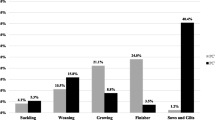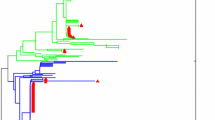Abstract
Porcine circovirus type 2 (PCV2) is the primary causative agent of porcine circovirus-associated diseases in swine, the most common of which are postweaning multisystemic wasting syndrome (PMWS) and porcine dermatitis and nephropathy syndrome (PDNS). To investigate the prevalence and genetic diversity of PCV2 in Hebei Province, Northern China, from 2016 to 2019, a total of 448 suspected cases of PCV2 infection were studied, and 179 samples were positive for PCV2. A pathological and histopathological examination suggested PCV2 to be cause of the observed lesions. Phylogenetic analysis showed that four genotypes were prevalent in Hebei Province: PCV2a, 2b, 2d, and 2e. Analysis of PCV2 strains using RDP4 and SimPlot showed that there were genetic recombination events among PCV2 strains in Hebei Province. A total of 3284 serum samples were screened by ELISA, and the positive rate of PCV2 antibodies was 73.9% (2428/3284). This study provides a scientific reference for the prevention and treatment of PCV2 in Hebei Province.









Similar content being viewed by others
References
Tischer I, Rasch R, Tochtermann G (1974) Characterization of papovavirus-and picornavirus-like particles in permanent pig kidney cell lines. Zentralblatt fur Bakteriologie, Parasitenkunde, Infektionskrankheiten und Hygiene Erste Abteilung Originale Reihe A: Medizinische Mikrobiologie und Parasitologie 226:153–167
Phan TG, Giannitti F, Rossow S, Marthaler D, Knutson TP, Li L, Deng X, Resende T, Vannucci F, Delwart E (2016) Detection of a novel circovirus PCV3 in pigs with cardiac and multi-systemic inflammation. Virology J 13:184
Palinski R, Pineyro P, Shang PC, Yuan FF, Guo R, Fang Y, Byers E, Hause BM (2017) A novel porcine circovirus distantly related to known circoviruses is associated with porcine dermatitis and nephropathy syndrome and reproductive failure. J Virol 91:e01879–16
Gillespie J, Opriessnig T, Meng XJ, Pelzer K, Buechner-Maxwell V (2009) Porcine circovirus type 2 and porcine circovirus-associated disease. J Vet Intern Med 23:1151–1163
Afolabi KO, Iweriebor BC, Okoh AI, Obi LC (2017) Global status of porcine circovirus type 2 and its associated diseases in Sub-Saharan Africa. Adv Virol 2017:6807964
He J, Cao J, Zhou N, Jin Y, Wu J, Zhou J (2013) Identification and functional analysis of the novel ORF4 protein encoded by porcine circovirus type 2. J Virol 87:1420–1429
Karuppannan AK, Opriessnig T (2017) Porcine circovirus type 2 (PCV2) vaccines in the context of current molecular epidemiology. Viruses 9(5):99
Olvera A, Cortey M, Segales J (2007) Molecular evolution of porcine circovirus type 2 genomes: phylogeny and clonality. Virology 357:175–185
Xiao CT, Halbur PG, Opriessnig T (2015) Global molecular genetic analysis of porcine circovirus type 2 (PCV2) sequences confirms the presence of four main PCV2 genotypes and reveals a rapid increase of PCV2d. J Gen Virol 96:1830–1841
Bao F, Mi S, Luo Q, Guo H, Tu C, Zhu G, Gong W (2018) Retrospective study of porcine circovirus type 2 infection reveals a novel genotype PCV2f. Transbound Emerg Dis 65:432–440
Beach NM, Smith SM, Ramamoorthy S, Meng X-J (2011) Chimeric porcine circoviruses (PCV) containing amino acid epitope tags in the C terminus of the capsid gene are infectious and elicit both anti-epitope tag antibodies and anti-PCV type 2 neutralizing antibodies in pigs. J Virol 85:4591–4595
Lekcharoensuk P, Morozov I, Paul PS, Thangthumniyom N, Wajjawalku W, Meng XJ (2004) Epitope mapping of the major capsid protein of type 2 porcine circovirus (PCV2) by using chimeric PCV1 and PCV2. J Virol 78:8135–8145
Kim SC, Nazki S, Kwon S, Juhng JH, Mun KH, Jeon DY, Jeong CG, Khatun A, Kang SJ, Kim WI (2018) The prevalence and genetic characteristics of porcine circovirus type 2 and 3 in Korea. BMC Vet Res 14:294
Yang S, Yin S, Shang Y, Liu B, Yuan L, Zafar Khan MU, Liu X, Cai J (2018) Phylogenetic and genetic variation analyses of porcine circovirus type 2 isolated from China. Transbound Emerg Dis 65:e383–e392
Li L, Yuan W, Guo H, Ma Z, Song Q, Wang X, Li H (2016) Prevalence and genetic variation of porcine circovirus type 2 in Hebei, China from 2004 to 2014. Gene 586:222–227
Arcega RS, Woo JS, Xu H (2019) Performing and cutting frozen sections. Methods Mol Biol (Clifton, NJ) 1897:279–288
Jiang C-G, Wang G, Tu Y-B, Liu Y-G, Wang S-J, Cai X-H, An T-Q (2017) Genetic analysis of porcine circovirus type 2 in China. Arch Virol 162(9) : 2715–2726
Bolin SR, Stoffregen WC, Nayar GP, Hamel AL (2001) Postweaning multisystemic wasting syndrome induced after experimental inoculation of cesarean-derived, colostrum-deprived piglets with type 2 porcine circovirus. J Vet Diagn Investig 13:185–194
Magar R, Larochelle R, Thibault S, Lamontagne L (2000) Experimental transmission of porcine circovirus type 2 (PCV2) in weaned pigs: a sequential study. J Comp Pathol 123:258–269
Meng X-J (2012) Porcine circovirus type 2 (PCV2): pathogenesis and interaction with the immune system. Ann Rev Animal Biosci 1(1):43–64
Baró J, Segalés J, Martínez J (2015) Porcine circovirus type 2 (PCV2) enteric disease: an independent condition or part of the systemic disease? Vet Microbiol 176:83–87
Baumgartner M, Brugnera E, Sydler T, Bürgi E, Hässig M (2012) Risk factors causing postweaning multisystemic wasting syndrome (PMWS) onset in Swiss pig farms. SAT Schweizer Archiv für Tierheilkunde 154:429–436
Barman NN, Nath B, Kumar V, Sen A, Dutta TK (2018) The emergence of porcine circovirus 2 infections in the Northeastern part of India: a retrospective study from 2011 to 2017. Transbound Emerg Dis 65:1959–1967
Beach NM, Meng XJ (2012) Efficacy and future prospects of commercially available and experimental vaccines against porcine circovirus type 2 (PCV2). Virus Res 164:33–42
Firth C, Charleston MA, Duffy S, Shapiro B, Holmes EC (2009) Insights into the evolutionary history of an emerging livestock pathogen: porcine circovirus 2. J Virol 83:12813–12821
Liu XF, Song T, Rui P, Tian R, Hao JX, Wang QY, Liu XR, Xin SY, Zhang SC, Ma ZJ (2018) Genetic variation analysis of prevalent porcine circovirus type 2 strains in northern Hebei province. Chin J Vet Sci 38(11):2039–2043
Tassis PD, Tsakmakidis I, Papatsiros VG, Koulialis D, Nell T, Brellou G, Tzika ED (2017) A randomized controlled study on the efficacy of a novel combination vaccine against enzootic pneumonia (Mycoplasma hyopneumoniae) and porcine Circovirus type 2 (PCV2) in the presence of strong maternally derived PCV2 immunity in pigs. BMC Vet Res 13:91
Xia D, Huang L, Xie Y, Zhang X, Wei Y, Liu D, Zhu H, Bian H, Feng L, Liu C (2019) The prevalence and genetic diversity of porcine circovirus types 2 and 3 in Northeast China from 2015 to 2018. Arch Virol 164:2435–2449
Liu J, Wei C, Dai A, Lin Z, Fan K, Fan J, Liu J, Luo M, Yang X (2018) Detection of PCV2e strains in Southeast China. Peer J 6:e4476
Zhang D, He K, Wen L, Fan H (2015) Genetic and phylogenetic analysis of a new porcine circovirus type 2 (PCV2) strain in China. Arch Virol 160:3149–3151
Mahe D, Blanchard P, Truong C, Arnauld C, Le Cann P, Cariolet R, Madec F, Albina E, Jestin A (2000) Differential recognition of ORF2 protein from type 1 and type 2 porcine circoviruses and identification of immunorelevant epitopes. J Gen Virol 81:1815–1824
Neira V, Ramos N, Tapia R, Arbiza J, Neira-Carrillo A, Quezada M, Ruiz A, Bucarey SA (2017) Genetic analysis of porcine circovirus type 2 from pigs affected with PMWS in Chile reveals intergenotypic recombination. Virol J 14:191
Zhou JY, Chen QX, Ye JX, Shen HG, Chen TF, Shang SB (2006) Serological investigation and genomic characterization of PCV2 isolates from different geographic regions of Zhejiang province in China. Vet Res Commun 30:205–220
Martelli P, Saleri R, Ferrarini G, De Angelis E, Cavalli V, Benetti M, Ferrari L, Canelli E, Bonilauri P, Arioli E, Caleffi A, Nathues H, Borghetti P (2016) Impact of maternally derived immunity on piglets’ immune response and protection against porcine circovirus type 2 (PCV2) after vaccination against PCV2 at different age. BMC Vet Res 12:77
Ouyang T, Zhang X, Liu X, Ren L (2019) Co-Infection of swine with porcine circovirus type 2 and other swine viruses. Viruses 11(2):185
Funding
This research was supported by the Program of the Modern Agriculture Industry Technology System Foundation of Hebei Province (HBCT2018110207), Science and Technology Innovation Program of Hebei Province for Graduate Students (CXZZBS2019095), and Key R & D Projects in Hebei Province, China (19226622D).
Author information
Authors and Affiliations
Contributions
YZZ and JHF as corresponding authors contributed to the conception of the study. LH, GFY, and SJC performed the data analysis and wrote the manuscript. FD and LSH contributed significantly to analysis and manuscript preparation. All authors have read and approved the manuscript.
Corresponding authors
Ethics declarations
Conflict of interest
The authors declare that they have no conflict of interest.
Ethics approval
Animal experiments were approved by the Animal Ethics Committee of Hebei Agricultural University (2019022). Permission was obtained from the farm owners for collection of samples.
Availability of data and material
All data and material generated or used during the study appear in the submitted article.
Additional information
Handling Editor: Ana Cristina Bratanich.
Publisher's Note
Springer Nature remains neutral with regard to jurisdictional claims in published maps and institutional affiliations.
Supplementary Information
Below is the link to the electronic supplementary material.
Rights and permissions
About this article
Cite this article
Han, L., Yuan, Gf., Chen, Sj. et al. Porcine circovirus type 2 (PCV2) infection in Hebei Province from 2016 to 2019: a retrospective study. Arch Virol 166, 2159–2171 (2021). https://doi.org/10.1007/s00705-021-05085-z
Received:
Accepted:
Published:
Issue Date:
DOI: https://doi.org/10.1007/s00705-021-05085-z




